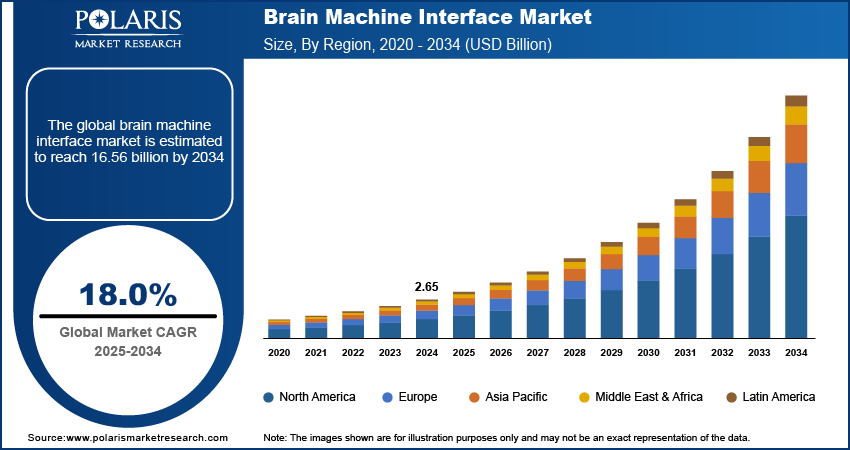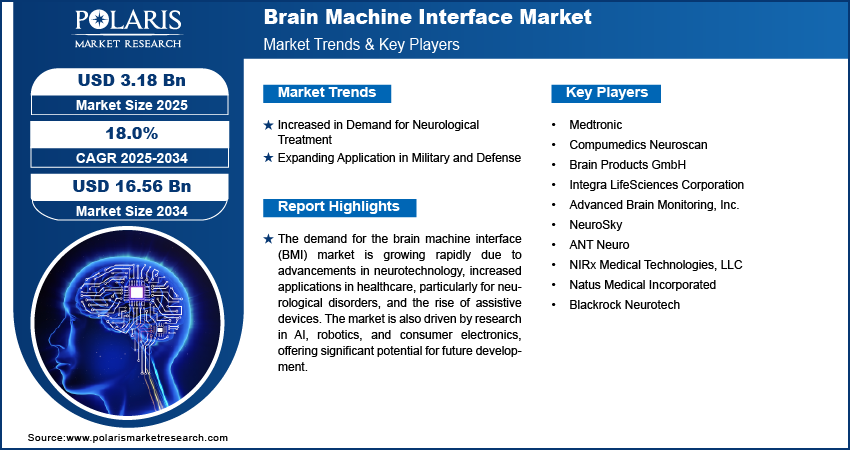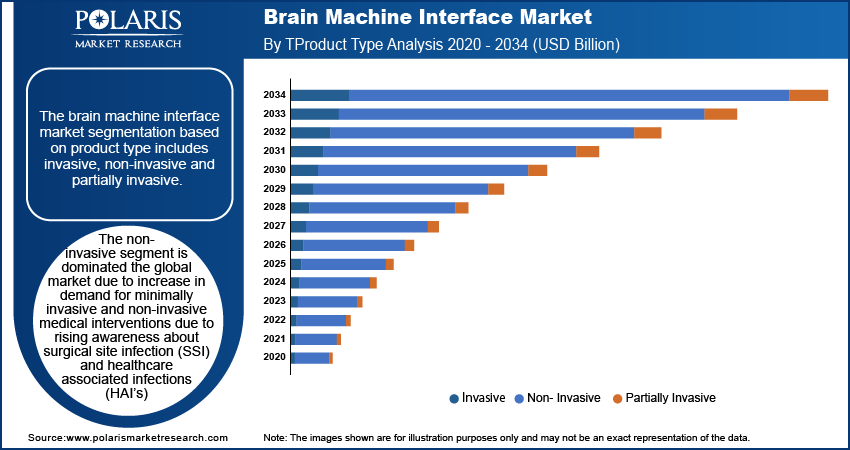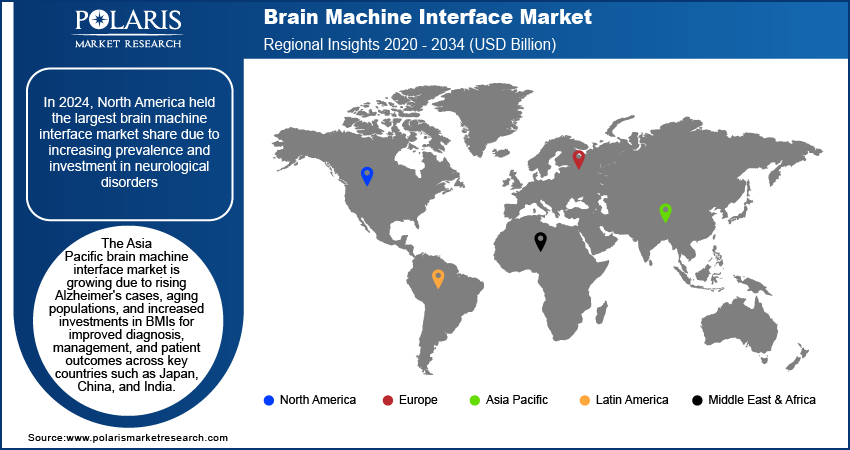
Global Brain Machine Interface Market Size, Share, Trends, Industry Analysis Report: By Component, By Product Type (Invasive, Non-Invasive and Partially Invasive) Technology, Application, End Users and Region (North America, Europe, Asia-Pacific, Latin America, and Middle East & Africa) – Market Forecast, 2025 – 2034
- Published Date:Dec-2024
- Pages: 125
- Format: PDF
- Report ID: PM5343
- Base Year: 2024
- Historical Data: 2020-2023
Brain Machine Interface Market Overview
Brain machine interface market size was valued at USD 2.65 billion in 2024. The industry is projected to grow from USD 3.18 billion in 2025 to USD 16.56 billion by 2034, exhibiting a CAGR of 18.0% during the forecast period.
The brain-machine interface, also known as a brain computer interface, is a technology that enables direct communication between the brain and an external device or system.
The brain machine interfaces market is mainly driven by advancements in neuroscience technology by leading companies. Major companies around the world with extensive research and development facilities have started focusing on new technological opportunities and current applications and product types, which are expected to drive the market during the forecast period. For Instance, in 2023, Philips introduced a mobile 1.5T MRI unit that signifies a significant advancement in technology, leading to a transformative change in neuroscience research and brain machine interface (BMI) development. This innovative MRI system, known for its lightweight design and helium-free operation, promises reduced costs and increased access to advanced imaging technology. These advancements in neuroscience are expected to drive the brain machine interface market growth.

To Understand More About this Research: Request a Free Sample Report
The market is expected to grow due to the advancement in artificial intelligence and machine learning. These technologies are revolutionizing BMIs by significantly improving their cost-effectiveness and operational efficiency. AI and ML algorithms improve the accuracy and speed of data interpretation from brain signals, leading to more reliable and real-time communication between the brain and external devices. This efficiency enhances the functionality of BMIs and also reduces the overall cost of development and implementation. AI-driven predictive models are expected to optimize device performance, minimize errors, and tailor interfaces to individual users' needs, making BMIs more accessible and affordable.
Machine learning algorithms enable continuous learning and adaptation, allowing BMIs to evolve and improve over time without substantial increases in cost. Advancement in this technology is anticipated to reduce the need for expensive, manual adjustments and streamline the integration process, thus lowering barriers to entry for both developers and end-users. Consequently, the convergence of AI and ML with BMIs is fostering more dynamic and cost-effective technologies, leading to the brain machine interface market expansion during the forecast period.
Brain Machine Interface Market Drivers and Trends
Increased in Demand for Neurological Treatment
The increasing prevalence of neurological disorders and neurodegenerative disorders is expected to drive the brain machine interface market growth during the forecast period. According to the American Association of Neurological Surgeons, In the US, there are 60,000 cases of Parkinson’s disease and 1.5 million deaths due to the disorder annually. Similarly, the country recorded 250,000 cases of dystonia as of April 2024. These trends are similar in other major regions, leading to a higher demand for neurological treatment. This surge in demand for effective neurological treatments is anticipated to boost the BMI market revenue as healthcare providers and researchers seek advanced technologies to address these challenging conditions. Furthermore, investments in the development and deployment of advanced brain-machine interfaces (BMIs) are expected to increase due to growing demand. This is expected to broaden their use in diagnosing and treating underserved neurological disorders. Consequently, the brain machine interface market is projected to grow positively during the forecast period.
Expanding Application in Military and Defense
The growing use of brain machine interfaces in military and defense is expected to drive market growth during the forecast period. Defense agencies are seeking to enhance operational effectiveness and soldier capabilities, and BMIs offer transformative potential. These interfaces facilitate advanced communication systems, enabling soldiers to control devices and systems directly through neural signals, thus improving reaction times and decision-making processes under high-pressure conditions. Additionally, BMIs are being explored for their potential to augment cognitive and sensory functions, providing soldiers with enhanced situational awareness and better integration with advanced technologies. This capability is particularly valuable for tasks requiring precision and rapid information processing, such as in uncrewed aerial vehicles (UAVs) and robotic systems. Moreover, the integration of BMIs has assisted in the development of advanced training simulators that influence combat scenarios with high fidelity, thereby improving training outcomes. Consequently, defense agencies are increasingly investing in BMI research and development to gain a strategic advantage and enhance operational effectiveness. This growing interest and investment in military and defense applications are anticipated to boost the brain machine interface market growth in the forecast period.

Brain Machine Interface Market Segment Insights
Brain Machine Interface Market Product Type Insights
The brain machine interface market segmentation based on product type includes invasive, non-invasive, and partially invasive. The non-invasive segment dominated the brain machine interface market share in 2024. This growth is attributed to the increase in demand for minimally invasive and non-invasive medical interventions due to rising awareness about surgical site infection (SSI) and healthcare-associated infections (HAIs). According to the Center for Disease Control and Prevention, the incidence of healthcare-associated infections occurs in every individual in a group of 31 hospital admissions in the United States. Thus, increasing awareness about infections has increased the demand for non-invasive or minimally invasive techniques for treatment, diagnosis, or any assistive devices.
Brain Machine Interface Market End User Insights
The brain machine interface market segmentation, based on end users, includes hospitals, clinics, rehabilitation centers, home care settings, and other end users. The hospitals segment is expected to register a significant CAGR during the brain machine interface market forecast. This growth is attributed to the increase in the prevalence of neurological diseases and neurodegenerative disorders. Hospitals are mainly in demand for surgeries due to better availability of resources and a skilled workforce. Therefore, the hospital is considered a major consumer in the brain machine interface market.

Brain Machine Interface Market Regional Insights
By region, the study provides the brain machine interface market insights into North America, Europe, Asia Pacific, Latin America, and Middle East & Africa. North America held the largest brain machine interface market share in 2024, driven by increasing prevalence and investment in neurological disorders. According to the American Medical Association, In the United States, the neurological disorders that contribute most significantly to the total number of Disability-Adjusted Life Years (DALYs) are stroke, Alzheimer's disease, other dementias, and migraines. Stroke alone accounts for 3.58 million DALYs. The increasing burden of these disorders, primarily driven by an aging population, has resulted in a growing demand for advanced treatments and technologies such as brain machine interfaces (BMIs).
Regional disparities also emphasize the varied impact, such as southeastern states experiencing a higher burden from stroke. In contrast, northern states see greater incidences of multiple sclerosis, and eastern states have heightened rates of Parkinson’s disease, epilepsy, and migraine. This geographic variation in neurological disorder prevalence underscores the regional demand for targeted BMI solutions. For instance, regions with a higher prevalence of specific conditions are likely to experience increased investment in BMIs designed to address those particular disorders. Additionally, the overall increase in neurological disorder burden from 1990 to 2020 accelerates brain machine interface market growth during the forecast period as healthcare providers and researchers seek innovative solutions to manage and mitigate these conditions.

The Asia Pacific is expected to register significant growth over the forecast period due to the increasing prevalence of Alzheimer's disease. For instance, the incidence rate of Alzheimer's in Asia-Pacific has grown from 96 per 1,000 people in 1990 to 108 per 1,000 people in 2020, indicating a growing demand for innovative therapeutic solutions. This increase is primarily driven by a rapidly aging population, particularly in countries such as Japan, China, and India, where the elderly population is expanding. This growing burden of Alzheimer's disease has led to a strengthened need for advanced brain machine interfaces (BMIs) to aid in diagnosis, management, and potentially slowing the progression of the disease. Thus, the brain machine interface market is experiencing significant growth as both public and private sectors invest in developing and deploying BMIs to address this critical health challenge, aiming to enhance patient outcomes and improve the quality of life for affected individuals in the region.
The market for brain machine interfaces (BMIs) in India is expected to grow significantly due to increased investments and the formation of strategic partnerships between global and local companies. This collaboration is creating a vibrant ecosystem that promotes innovation in neurotechnology. International companies are increasingly teaming up with Indian tech firms and research institutions, combining global expertise with local insights. These partnerships bring in vital funding and also facilitate the exchange of technologies and research capabilities, accelerating the development of advanced BMI solutions. India's supportive policy environment and government incentives for technological advancements are further contributing to the brain machine interface market expansion.
Local startups are reaping the benefits of these international collaborations, gaining access to new technologies and scaling their innovations more rapidly. The influx of investment and the establishment of joint ventures are driving research initiatives, improving product development, and expanding market opportunities. As a result of these factors, the market for brain machine interfaces is expected to grow during the forecast period.
Brain Machine Interface Market Key Market Players & Competitive Insights
The brain machine interface market is always evolving, with numerous companies striving to innovate and distinguish themselves. Leading global corporations dominate the market by leveraging extensive research and development, advanced manufacturing technologies, and significant capital to maintain a competitive edge. These companies pursue strategic initiatives such as mergers, acquisitions, partnerships, and collaborations to enhance their product offerings and expand into new markets.
New companies are impacting the industry by introducing innovative medical devices and meeting the needs of specific market sectors. This competitive environment is amplified by continuous progress in product offerings and new product types, greater emphasis on sustainability, and the rising requirement for tailor-made single-use products in diverse industries. Major players in the brain machine interface market, includes Medtronic; Compumedics Neuroscan; Brain Products GmbH; Integra LifeSciences Corporation; Advanced Brain Monitoring, Inc.; NeuroSky; ANT Neuro; NIRx Medical Technologies, LLC; Natus Medical Incorporated; and Blackrock Neurotech.
Medtronic, headquartered in Dublin, is an medical technology company. The company’s business line includes developing and manufacturing a diverse range of advanced medical devices, including pacemakers, insulin pumps, spinal implants, robotic surgical systems and deep brain stimulation systems. Medtronic's deals in treating conditions related to cardiovascular health, diabetes, neurological disorders, and spinal issues. The company has a presence in over 150 countries. In April 2024, Medtronic launched India’s first NeuroSmart Portable Micro Electrode Recording (MER) Navigation system for Parkinson’s treatment. The innovative system was introduced as a significant advancement in the treatment of Parkinson’s disease.
Natus Medical Incorporated is a global provider of medical devices and services focused on the diagnosis, monitoring, and treatment of neurological disorders, hearing impairment, and other medical conditions. The company is headquartered in Pleasanton, California, USA. Natus operates across multiple regions including North America, Europe, and Asia-Pacific, offering a range of products and solutions to healthcare professionals. The company is deals in neurodiagnostic and neuromonitoring technologies.
Key Companies in the Brain Machine Interface Market include:
- Medtronic
- Compumedics Neuroscan
- Brain Products GmbH
- Integra LifeSciences Corporation
- Advanced Brain Monitoring, Inc.
- NeuroSky
- ANT Neuro
- NIRx Medical Technologies, LLC
- Natus Medical Incorporated
- Blackrock Neurotech
Brain Machine Interface Market Industry Developments
March 2024: AAVAA’s new technology for integrating brain-computer interfaces (BCI) into smart glasses was announced recently. The BCI System for Smart Glasses was introduced to provide enhanced device control, significantly advancing AR/VR, smart home, gaming, and assistive technologies. This system was designed to seamlessly integrate with existing eyewear and goggles, delivering unprecedented convenience and functionality. The launch marked a notable advancement in accessibility and immersive experience technology.
May 2024: Neurable secured USD 13 million in funding for its brain-computer interface (BCI) technology, which integrates with everyday products. The Boston-based company announced that the funds were to be used to advance its platform technology and explore large-scale applications. The BCI AI technology was to be scaled through licensing, facilitating further development and experimentation across various industries. The investment was expected to enhance Neurable’s capabilities and support its ambitious plans for technological expansion.
May 2023: Cognixion has received FDA Breakthrough Device designation for its Cognixion ONE Axon, a noninvasive brain-computer interface with augmented reality designed to help individuals with severe motor impairments, like ALS, communicate through thought, AI, and wearable technology.
Brain Machine Interface Market Segmentation
By Component Outlook (USD billion, 2020 - 2034)
- Hardware
- Software
By Product Type Outlook (USD billion, 2020 - 2034)
- Invasive
- Non- Invasive
- Partially Invasive
By Technology Outlook (USD billion, 2020 - 2034)
- Electroencephalography (EEG)
- Functional magnetic resonance imaging (fMRI)
- Functional near-infrared spectroscopy (fNIRS)
- Positron emission tomography (PET)
- Magnetoencephalography (MEG)
- Electrocorticography (ECoG)
- Others
By Application Outlook (USD billion, 2020 - 2034)
- Neurorehabilitation
- Assessment and Diagnosis
- Disability Restoration
- Assistive Technology
- Others
By End User Outlook (USD billion, 2020 - 2034)
- Hospitals
- Clinics
- Rehabilitation Centers
- Home Care Settings
- Others
By Regional Outlook (USD billion, 2020 - 2034)
- North America
- US
- Canada
- Europe
- Germany
- France
- UK
- Italy
- Spain
- Netherlands
- Russia
- Rest of Europe
- Asia-Pacific
- China
- Japan
- India
- Malaysia
- South Korea
- Indonesia
- Australia
- Rest of Asia-Pacific
- Middle East & Africa
- Saudi Arabia
- UAE
- Israel
- South Africa
- Rest of Middle East & Africa
- Latin America
- Mexico
- Brazil
- Argentina
- Rest of Latin America
Brain Machine Interface Market Report Scope
|
Report Attributes |
Details |
|
Market size value in 2024 |
USD 2.65 billion |
|
Market size value in 2025 |
USD 3.18 billion |
|
Revenue Forecast in 2034 |
USD 16.56 billion |
|
CAGR |
18.0% from 2025 – 2034 |
|
Base year |
2024 |
|
Historical data |
2020 – 2023 |
|
Forecast period |
2025 – 2034 |
|
Quantitative units |
Revenue in USD billion and CAGR from 2025 to 2034 |
|
Report Coverage |
Revenue Forecast, Market Competitive Landscape, Growth Factors, and Trends |
|
Segments covered |
|
|
Regional scope |
|
|
Competitive Landscape |
|
|
Report Technology |
|
|
Customization |
Report customization as per your requirements with respect to countries, region and segmentation. |
FAQ's
The brain machine interface market size was valued at USD 2.65 billion in 2024 and is projected to grow to USD 16.56 billion by 2034.
The global market is projected to grow at a CAGR of 18.0 % during the forecast period, 2025–2034.
North America had the largest share in the global market
The key players in the market are Medtronic; Compumedics Neuroscan; Brain Products GmbH; Integra LifeSciences Corporation; Advanced Brain Monitoring, Inc.; NeuroSky; ANT Neuro; NIRx Medical Technologies, LLC; Natus Medical Incorporated; and Blackrock Neurotech.
The non-invasive segment dominated the global market.
The hospitals segment is expected to experience significant CAGR in the global market during the forecast period.
